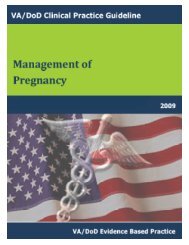DM Full Guideline (2010) - VA/DoD Clinical Practice Guidelines Home
DM Full Guideline (2010) - VA/DoD Clinical Practice Guidelines Home
DM Full Guideline (2010) - VA/DoD Clinical Practice Guidelines Home
You also want an ePaper? Increase the reach of your titles
YUMPU automatically turns print PDFs into web optimized ePapers that Google loves.
Version 4.0<br />
<strong>VA</strong>/<strong>DoD</strong> <strong>Clinical</strong> <strong>Practice</strong> <strong>Guideline</strong><br />
for the Management of Diabetes Mellitus<br />
Two RCTs showed that adding exenatide versus insulin glargine (mean doses 25-29U/day) to metformin, SU or both<br />
metformin +SU resulted in a similar reduction in HbA 1 c; however, reduction in fasting glucose was greater with<br />
insulin glargine. Exenatide use resulted in mean weight loss (2-3kg) whereas insulin glargine use resulted in mean<br />
weight gain (1.0-2.3kg). The results for overall hypoglycemia were inconsistent, where 1 study showed no<br />
difference between glargine and exenatide and the other showed significantly fewer episodes with exenatide. The<br />
rate of nocturnal hypoglycemia was lower with exenatide in both studies. In a subgroup of patients receiving SU as<br />
background therapy, the rate of hypoglycemia was similar with exenatide and glargine. The exenatide group<br />
reported a greater incidence of adverse GI effects and had more patients dropping out of the studies (Heine et al.,<br />
2005; Barnett et al., 2007).<br />
In patients with inadequate glycemic control on combination metformin + SU, the addition of exenatide versus<br />
biphasic insulin aspart was compared in a 52-week and 24-week trial. The 52-week study showed no significant<br />
difference in reduction in HbA 1 c between the 2 agents (mean insulin dose 24.4U) and in overall incidence of<br />
hypoglycemia; however, exenatide was associated with less nocturnal hypoglycemia (0.6 vs.1.1 events/patient-year).<br />
On the contrary, the 24-week treat-to-target study found that reduction in HbA1c with biphasic insulin aspart was<br />
superior compared to exenatide and had significantly greater rate of hypoglycemia. Both studies showed exenatide<br />
use resulted in mean weight loss (2-2.5kg) whereas biphasic aspart insulin use resulted in mean weight gain (2.9-<br />
4kg). The exenatide group reported a greater incidence of adverse GI effects and had more patients dropping out of<br />
the studies (Bergenstal et al., 2009; Nauck et al., 2007a)<br />
Triple oral therapy<br />
The long-term safety and efficacy of three oral hypoglycemic agents is unknown. For patients who have not<br />
achieved their glycemic goal on a 2-drug oral regimen, addition of once daily or bedtime insulin is preferred.<br />
However, addition of a third oral agent could be considered for those who are not good candidates for insulin or<br />
decline insulin use and the target HbA1c is within the efficacy range of the oral agent. (Dailey et al., 2004;<br />
Hermansen et al., 2007; Roberts et al., 2005; Rosenstock et al., 2006b).<br />
Four drug oral therapy<br />
The efficacy and safety of such a combination is not known and should be strongly discouraged. Such a trial might<br />
rarely be considered in patients with inadequate glycemic control on 3-drug therapy and are not good candidates for<br />
the addition of insulin.<br />
Combination with Insulin<br />
The data seems to suggest that patients receiving combination treatment with oral hypoglycemic agents (OHAs) plus<br />
insulin have significantly lower HbA1c levels when compared to those treated with insulin monotherapy. However,<br />
studies in this area have several limitations: 1.Fasting plasma glucose values were not consistently assessed by most<br />
of the studies; 2. Many of the studies had small sample sizes and/or were of low quality, and several were openlabeled;<br />
and 3. Direct comparison between studies is hampered by the number of different drug combinations and<br />
comparisons, and dosing and titration regimens.<br />
A Cochrane review (Goudswaard et al., 2004) of randomized controlled trials assessing the effects of insulin<br />
monotherapy versus insulin-OHA combinations therapy found that bedtime NPH insulin combined with oral<br />
hypoglycemic agents provided comparable glycemic control to insulin monotherapy and was associated with less<br />
weight gain if metformin is used.<br />
• Insulin-OHA combination therapy had statistically significant benefits on glycemic control (mean<br />
difference 0.3% (95% CI 0.0 to 0.6, p=0.03)) over insulin monotherapy only when the latter was applied as<br />
a once-daily injection of NPH insulin<br />
• Conversely, twice-daily insulin monotherapy (NPH or mixed insulin) provided superior glycemic control<br />
(mean difference 0.4% (95% CI 0.1 to 0.8, p=0.03)) to insulin-OHA combination therapy regimens where<br />
insulin was administered as a single morning injection.<br />
• Regimens utilizing OHAs with bedtime NPH insulin provided comparable glycemic control to insulin<br />
monotherapy (administered as twice or more daily injections).<br />
• Overall, insulin-OHA combination therapy was associated with a 43% reduction in total daily insulin<br />
requirement compared to insulin monotherapy.<br />
Module G: Glycemic Control Page 59
















